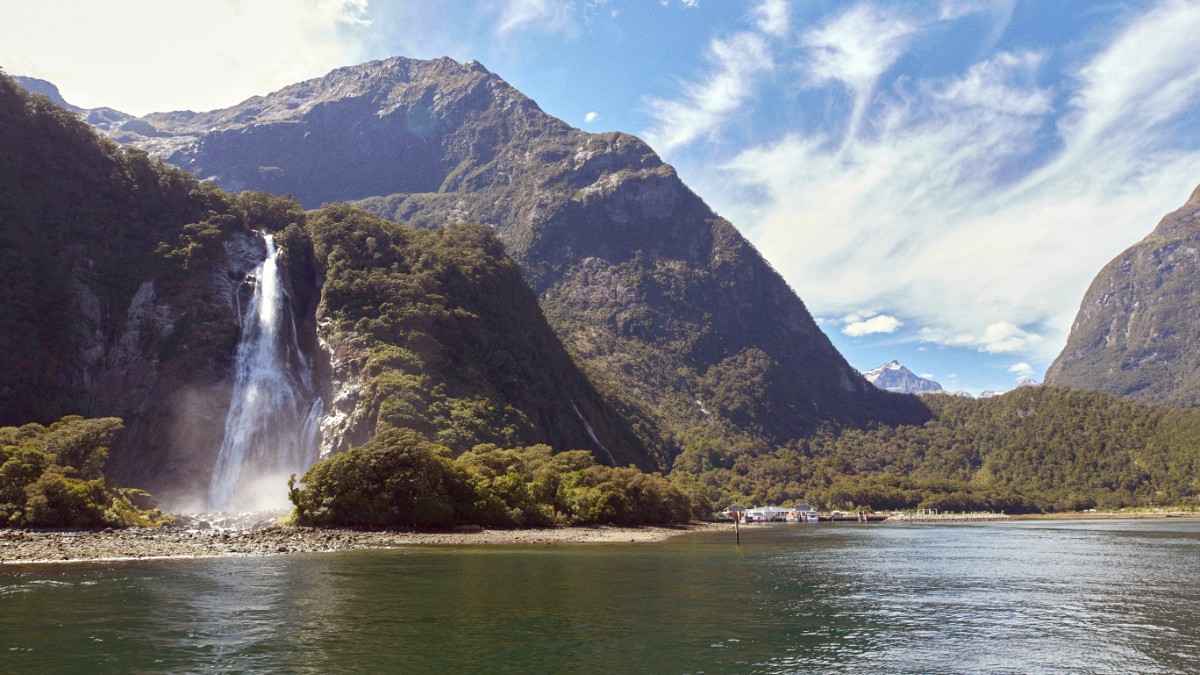
Fiordland And Southland, New Zealand
The Milford Sound Cruise is the quintessential, main attraction. A cruise on Milford Sound navigates deep into the fiord, providing unparalleled views of its dramatic landscapes.
Cruises typically last 1.5 to 2.5 hours, depending on the operator and chosen itinerary. They travel the length of the fiord towards the Tasman Sea entrance before returning. Visitors experience the immense scale of the cliffs, feel the spray of waterfalls, and spot wildlife. Book your cruise in advance, especially during peak season (December-February). Guided commentary covers geology, history, and wildlife. Early morning and late afternoon cruises often see fewer people. Book Milford Sound cruises on GetYourGuide.
These provide insight into the region's natural and cultural context.
Established in the late 19th century, one of New Zealand's oldest and most famous hiking routes. Originally a challenging route for Māori, later for explorers and early tourists.
Retained its pristine natural beauty, becoming a world-renowned multi-day trek. Its history as a "Great Walk" and role in early tourism gives it historical importance.
The entirety of Milford Sound and Fiordland National Park constitutes a vast natural attraction.
Milford Sound is within this UNESCO World Heritage Area (1.2 million hectares). Characterized by dramatic fiords, alpine lakes, dense ancient rainforests, and diverse wildlife.
A broad, U-shaped valley along Milford Road. Formed by glacial action, it offers panoramic views of glaciated landscapes and ancient beech forests.
Lake Te Anau: Largest lake in South Island, gateway to Fiordland. Lake Manapouri: Second largest in Fiordland, gateway to Doubtful Sound.
Commonly seen basking on rocks in Milford Sound, especially at Seal Rock, a regular cruise stop. Playful and visible year-round.
A resident pod occasionally graces Milford Sound waters. Sightings are not guaranteed but are a delightful bonus.
Kea (alpine parrots) seen at Homer Tunnel and along Milford Road; do not feed. Listen for tui, bellbird, and fantail in rainforests around Te Anau.
Explore numerous short walks along Milford Road. These walks offer glimpses into the park's diverse ecosystems.
Accessible from Milford Road, this valley leads to diverse landscapes, including coastal areas. Provides access points for longer hikes like the Hollyford Track.
These shy and endangered penguins are best seen during their breeding season (July-November). Harder to spot, visible near specific coastal areas from cruise boats.
While Milford Sound's main attractions are well-known, a few places offer a quieter experience or an unique perspective.
Milford Sound itself is a testament to natural forces and human ingenuity in accessing a remote wonder.
The region's attractions mainly focus on its pristine natural environment and the activities it supports. Plan your itinerary to balance popular cruises with shorter walks and historical insights along the Milford Road.
Maximize your scenic cruise experience with these pointers.
Practical advice for road travel and walking trails.
Your main resource for Fiordland National Park.
More than just a hiking trail, it holds profound historical meaning.
Milford Sound remains a truly wild and awe-inspiring destination.
Cruises offer the most comprehensive views of the fiord's iconic landmarks.
The Homer Tunnel and Milford Track historical contexts provide understanding.
Short walks along Milford Road offer glimpses into diverse park ecosystems.
The essential way to experience the fiord, with options for various operators and itineraries.
Book your cruiseMilford Sound's iconic mountain, best appreciated from the water.
Powerful waterfalls creating a misty spectacle from cruise boats.
Short walks along Milford Road offering unique natural formations and reflections.
Located in Te Anau, a main resource for park information and bookings.
Visit DOC websiteExplore quieter corners and unique viewing opportunities.
The region's history shapes its identity.
Your visit to Milford Sound gains depth by exploring beyond the cruise.
Allocate time for short walks, the Homer Tunnel, and the Visitor Centre in Te Anau to enrich your understanding of this extraordinary place.
Milford Sound remains an unforgettable experience. Maximize your visit by engaging with its natural wonders, understanding its history, and spotting its unique wildlife.
Immerse yourself in Fiordland's untouched wilderness.
Keep an eye out for Fiordland's unique inhabitants.
The iconic symbol of Milford Sound, best viewed from the water.
Dominates the landscape and embodies Milford Sound's grandeur.
The Homer Tunnel, an engineering marvel, opened the fiord to the world.
Mirror Lakes and The Chasm offer tranquil beauty and geological wonders.
Ideal stops for appreciating natural artistry and tranquility.
Milford Sound Cruise and Mitre Peak views are central to the visit.
Don't miss The Chasm and Mirror Lakes on Milford Road.
Fiordland National Park Visitor Centre and historical sites enrich understanding.